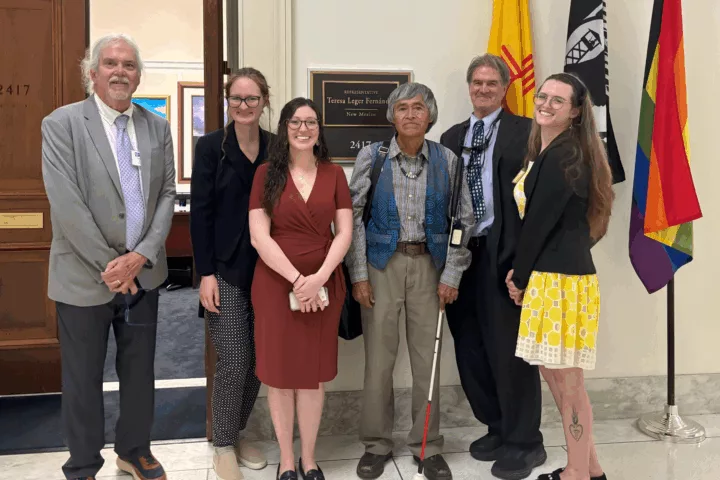In April Nuclear Watch New Mexico released a map of plutonium contamination based on Lab data. Today, Dr. Michael Ketterer, Professor Emeritus of Chemistry and Biochemistry, Northern Arizona University, is releasing alarmingly high results from samples taken from a popular walking trail in the Los Alamos Town Site, including detections of some of the earliest plutonium produced by humankind.
On July 2 and 17 Dr. Ketterer, with the assistance of Nuclear Watch New Mexico, collected water, soil and plant samples from Acid Canyon in the Los Alamos Town Site and soil and plant samples in Los Alamos Canyon at the Totavi gas station downstream from the Lab. The samples were prepared and analyzed by mass spectrometry at Northern Arizona University to measure concentrations of plutonium, and to ascertain its sources in the environment.
For water samples, concentration is expressed in picocuries1 per liter (pCi/L) and for soil and plants in picocuries per gram (pCi/g). The provenance of the plutonium was determined through isotopic examination of the ratio of 239Pu atoms to 240Pu atoms, which distinguishes it from global nuclear weapons testing fallout.
Acid Canyon is located in the heart of the Los Alamos Town Site, contiguous to the busy Aquatic Center which also has the trailhead for the popular walk into the Canyon. From 1943 to 1963 radioactive liquid wastes were disposed by piping them over the Canyon wall (plutonium is often processed with nitric acid, hence the Canyon’s name). Acid Canyon ultimately drains via the Los Alamos Canyon through San Ildefonso Pueblo lands to the Rio Grande. Earlier studies have identified Lab plutonium as far as 17 miles south in Cochiti Lake.
The Atomic Energy Commission “cleaned up” Acid Canyon in 1967 and released the land to Los Alamos County without restrictions. The Department of Energy performed some additional remediation and in 1984 certified that Acid Canyon was “in compliance with applicable DOE standards and guidelines for cleanup and that radiological conditions were protective of human health and the environment… No monitoring, maintenance, or site inspections are required.”2
Forty years later, Dr. Ketterer’s monitoring and inspections strongly indicate otherwise. His samples showed 239+240Pu activities as high as 86 pCi/L in water, 78 pCi/g in sediments, and 5.7 pCi/g in plant ash. He concluded:
“The 239+240Pu activities in all four water samples exceed the federal Environmental Protection Agency’s relevant gross alpha standard of 50 pCi/L and draw attention to an egregious water contamination problem mandating prompt USEPA and/or State intervention. This warrants 2 immediate postings and efforts by State/local agencies to warn people and their pets away from contacting Acid Canyon water.” While noting the threat of wildfires, as locals will recall the 2000 Cerro Grande Fire that forced the mandatory evacuations of the Lab and Los Alamos Town Site, Dr. Ketterer added, “Of particular concern is the possibility of wildfire in Acid Canyon. The activity concentrations of 239+240Pu in Acid Canyon sediments and plant matter, along with the Canyon’s close proximity to residential areas of Los Alamos, represents an alarming potential situation of plutonium releases into the air, should a wildfire engulf the canyon.”
Approximately seven miles downstream from Acid Canyon, Dr. Ketterer found “Significant plant uptake of 239+240Pu near the Totavi Philips 66 station along NM Highway 502.”
Of historic interest, he noted, “The repeated, consistent pattern of 240Pu/239Pu in the range 0.010 – 0.015, observed in the highly contaminated Acid Canyon sediments, water and vegetation, indicates that the Pu in Acid Canyon is some of the oldest known Pu contamination in the ambient environment – a portion of which likely pre-dates the Trinity Test itself.”
Jay Coghlan, Director of Nuclear Watch, commented,
“Dr. Ketterer’s independent sampling of historic plutonium contamination demonstrates once again that we can’t trust the Department of Energy. This rings especially true as LANL plans to cut cleanup while spending at least $8 billion over the next 5 years to expand the production of plutonium “pit” bomb cores. We demand comprehensive cleanup of past radioactive contaminants and protection from the future radioactive wastes that will be generated by the new nuclear arms race.”
# # #
Dr. Michael Ketterer’s methodology, findings and conclusions are available at https://nukewatch.org/wp-content/uploads/2024/08/Ketterer-AcidCanyon-13Aug2024.pdf
This press release is available at https://nukewatch.org/high-detections-of-plutonium-in-los-alamos-neighborhood/
1 A curie is a unit of radioactivity that has 37 billion atomic disintegrations per second (originally linked to the radioactivity of one gram of radium226). A picocurie is one trillionth of a curie. Plutonium is most dangerous when inhaled since alpha particles can kill lung cells, possibly leading to lung disease and cancer.
2 Fact sheet: Acid/Pueblo Canyon, New Mexico, DOE Legacy Management, https://www.energy.gov/lm/articles/acidpueblo-canyon-new-mexico-site-fact-sheet


